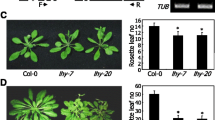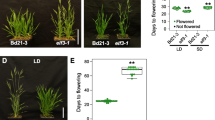Abstract
In order to understand some aspects of the circadian clock function in Phaseolus vulgaris, we analyzed the temporal transcript profile of Lhcb genes, typical clock reporters in plants, and that of PvLHY, an orthologue of Arabidopsis thaliana LHY which is a putative transcription factor of Lhcb genes. Under different light regimes, Lhcb and PvLHY exhibit a clear circadian pattern of expression. Moreover, the rhythm of Lhcb genes appears to be tightly coupled to that of PvLHY with the latter having a slightly earlier phase. This supports the idea that the oscillating capacity of PvLHY may be one of the causes of the rhythmic expression of Lhcb genes in bean. In addition to their circadian regulation, Lhcb and PvLHY are induced by light with similar and relatively slow induction kinetics. Moreover, this light induction is gated by the circadian oscillator: minimal responses occur at times around peaks of the pre-existing rhythm, while maximal ones occur at troughs of the pre-existing rhythm. This pattern of gating is opposite to that observed in Arabidopsis. The failure to block the light induction pathways at pre-existing troughs appears to have a detrimental effect to the subsequent circadian rhythmicity. Briefly, the overall regulation of PvLHY and Lhcb genes by light and the circadian clock reveals different strategies between Phaseolus and Arabidopsis in the adaptation to photoperiodic conditions.
Similar content being viewed by others
References
Alabadí, D., Oyama, T., Yanovsky, M.J., Harmon, F.G., Más, P. and Kay, S.A. 2001. Reciprocal regulation between TOC1 and LHY/CCA1 within the Arabidopsis circadian clock. Science 293: 880–883.
Alabadí, D., Yanovsky, Más, P., M.J., Harmer, S.L. and Kay, S.A. 2002. Critical role for CCA1 and LHY in maintaining circadian rhythmicity in Arabidopsis. Curr. Biol. 12: 757–761.
Alexander, L., Falconet, D., Fristensky, B.W., White, M.J., Watson, J.C., Roe, B.A. and Thompson, W.F. 1991. Nucleotide sequence of Cab-8, a new type I gene encoding a chlorophyll a/b-binding protein of LHC II in Pisum. Plant Mol. Biol. 17: 523–526.
Anderson, S.L., Somers, D.E., Millar, A.J., Hanson, K., Chory, J. and Kay, S.A. 1997. Attenuation of phytochrome A and B signaling pathways by the Arabidopsis circadian clock. Plant Cell 9: 1727–1743.
Beator, J. and Kloppstech, K. 1994. Circadian rhythmicity in the expression of genes in higher plants. Mol. Biol. 13: 203–219.
Carré, I.A. and Kim, J.-Y. 2002. MYB transcription factors in the Arabidopsis circadian clock. J. Exp. Bot. 53: 1551–1557.
Corpet, F. 1988. Multiple sequence alignment with hierarchical clustering. Nucl. Acids Res. 16: 10881–10890.
Covington, M.F., Panda, S., Liu, X.L., Strayer, C.A., Wagner, D.R. and Kay, S.A. 2001. ELF3 modulates resetting of the circadian clock in Arabidopsis. Plant Cell 13: 1305–1315.
Dunlap, J.C. 1999. Molecular bases for circadian clocks. Cell 96: 271–290.
Green, R.M., Tingay, S., Wang, Z.-Y. and Tobin, E.M. 2002. Circadian rhythms confer a higher level of fitness to Arabidopsis plants. Plant Physiol. 129: 576–584.
Green, R.M. and Tobin, E.M. 1999. Loss of the circadian clockassociated protein 1 in Arabidopsis results in altered clockregulated gene expression. Proc. Natl. Acad. Sci. USA 96: 4176–4179.
Harmer, S.L., Hogenesch, J.B., Straume, M., Chang, H.-S., Han, B., Zhu, T., Wang, X., Kreps, J.A. and Kay, S.A. 2000. Orchestrated transcription of key pathways in Arabidopsis by the circadian clock. Science 290: 2110–2113.
Karlin-Neumann, G., Sun, L. and Tobin, E.M. 1988. Expression of light-harvesting chlorophyll a/b protein genes is phytochrome regulated in etiolated Arabidopsis thaliana seedlings. Plant Physiol. 88: 1323–1331.
Kellmann, J.W., Merforth, N., Wiese, M., Pichersky, E. and Piechulla, B. 1993. Concerted circadian oscillations in transcript levels of nineteen genes in Lycopersicon esculentum (tomato). Mol. Gen. Genet. 237: 439–448.
Kim, J.-Y., Song, H.-R., Taylor, B.L. and Carré, I.A. 2003. Lightregulated translation mediates gated induction of the Arabidopsis clock protein LHY. EMBO J. 22: 935–944.
Kircher, S., Kosma-Bognar, L., Kim, L., Adam, E., Harter, K., Schäfer, E. and Nagy, F. 1999. Light quality-dependent nuclear import of the plant photoreceptors phytochrome A and B. Plant Cell 11: 1445–1456.
Kircher, S., Gil, P., Kosma-Bognar, L., Fejes, E., Speth, V., Husselstein-Muller, T., Bauer, D., Adam, E., Schäfer, E. and Nagy, F. 2002. Nucleocytoplasmic partitioning of the plant photoreceptors phytochrome A, B, C, D and E is regulated differentially by light and exhibits a diurnal rhythm. Plant Cell 14: 1541–1555.
Liu, X.L., Covington, M.F., Fankhauser, C., Chory, J. and Wagner, D.R. 2001. ELF3 encodes a circadian clock-regulated nuclear protein that functions in an Arabidopsis PHYB signal transduction pathway. Plant Cell 13: 1293–1304.
Makino, S., Matsushika, A., Kojima, M., Yamashino, T. and Mizuno, T. 2002. The APRR1/TOC1 quintet implicated in circadian rhythms of Arabidopsis thaliana. I. Characterization with APRR1-overexpressing plants. Plant Cell Physiol. 43: 58–69.
Martínez-García, J.F., Huq, E. and Quail, P.H. 2000. Direct targeting of light signals to a promoter element-bound transcription factor. Science 288: 859–863.
Más, P., Alabadí, D., Yanovsky, M.J., Oyama, T. and Kay, S.A. 2003. Dual role of TOC1 in the control of circadian and photomorphogenic responses in Arabidopsis. Plant Cell 15: 223–236.
McWatters, H.G., Bastow, R.M., Hall, A. and Millar, A. 2000. The ELF3 zeitnehmer regulates light signalling to the circadian clock. Nature 408: 716–720.
Michael, T.P. and McClung, C.R. 2002. Phase-specific circadian clock regulatory elements in Arabidopsis. Plant Physiol. 130: 627–638.
Millar, A.J. and Kay, S.A. 1996. Integration of circadian and phototransduction pathways in the network controlling CAB gene transcription in Arabidopsis. Proc. Natl. Acad. Sci. USA 93: 15491–15496.
Mizoguchi, T., Wheatley, K., Hanzawa, Y., Wright, L., Mizoguchi, M., Song, H.-R., Carré, I.A. and Coupland, G. 2002. LHY and CCA1 are partially redundant genes required to maintain circadian rhythms in Arabidopsis. Dev. Cell 2: 629–641.
Ni, M., Tepperman, J.M. and Quail, P.H. 1998. PIF3, a phytochrome-interacting factor necessary for normal photoinduced signal transduction, is a novel basic helix-loop-helix protein. Cell 95: 657–667.
Ni, M., Tepperman, J.M. and Quail, P.H. 1999. Binding of phytochrome B to its nuclear signaling partner PIF3 is reversibly induced by light. Nature 400: 781–784.
Piechulla, B., Merforth, N. and Rudolph, B. 1998. Identification of tomato Lhc promoter regions necessary for circadian expression. Plant Mol. Biol. 38: 655–662.
Roden, L.C., Song, H.-R., Jackson, S., Morris, K. and Carré, I.A. 2002. Floral responses to photoperiod are correlated with the timing of rhythmic expression relative to dawn and dusk in Arabidopsis. Proc. Natl. Acad. Sci. USA 99: 13313–13318.
Saghai-Maroof, M.A., Soliman, K.M., Jorgensen, R.A. and Allard, R.W. 1984. Ribosomal DNA spacer-length polymorphisms in barley: mendelian inheritance, chromosomal location, and population dynamics. Proc. Natl. Acad. Sci. USA 81: 8014–8018.
Schaffer, R., Ramsay, N., Samach, A., Corden, S., Putterill, J., Carré, I.A. and Coupland, G. 1998. The late elongate hypocotyl mutation of Arabidopsis disrupts circadian rhythms and the photoperiodic control of flowering. Cell 93: 1219–1229.
Somers, D.E. 1999. The physiology and molecular bases of the plant circadian clock. Plant Physiol. 121: 9–19.
Staiger, D., Allenbach, L., Salathia, N., Fiechter, V., Davis, S.J., Millar, A.J., Chory, J. and Fankhauser, C. 2003. The Arabidopsis SRR1 gene mediates phyB signaling and is required for normal circadian clock function. Genes Dev. 17: 256–268.
Strayer, C.A., Oyama, T., Schultz, T.F., Raman, R., Somers, D.E., Más, P., Panda, S., Kreps, J.A. and Kay, S.A. 2000. Cloning of the Arabidopsis clock gene TOC1, an autoregulatory response regulator homolog. Science 289: 768–771.
Sugiyama, N., Izawa, T., Oikawa, T. and Shimamoto, K. 2001. Light regulation of circadian clock-controlled gene expression in rice. Plant J 26: 607–615.
Tavladoraki, P., Kloppstech, K. and Argyroudi-Akoyunoglou, J.H. 1989. Circadian rhythm in the expression of the mRNA coding for the apoprotein of the light-harvesting complex of photosystem II. Phytochrome control and persistent far red reversibility. Plant Physiol. 90: 665–672.
Wang, Z.-Y., Kenigsbuch, D., Sun, L., Harel, E., Ong, M.S. and Tobin, E.M. 1997. A Myb-related transcription factor is involved in the phytochrome regulation of an Arabidopsis Lhcb gene. Plant Cell 9: 491–507.
Wang, Z.-Y. and Tobin, E.M. 1998. Constitutive expression of the CIRCADIAN CLOCK ASSOCIATED 1 (CCA1) gene disrupts circadian rhythms and suppresses its own expression. Cell 93: 1207–1217.
Wehmeyer, B., Cashmore, A.R. and Schafer, E. 1990. Photocontrol of the expression of genes encoding chlorophyll a/b binding proteins and small subunit of ribulose-1,5-bisphosphate carboxylase in etiolated seedlings of Lycopersicon esculentum (L.) and Nicotiana tabacum (L.). Plant Physiol. 93: 990–997.
Xu, Y. and Johnson, C.H. 2001. A clock-and light-regulated gene that links the circadian oscillator to LHCB gene expression. Plant Cell 13: 1411–1425.
Yamaguchi, R., Nakamura, M., Mochizuki, N., Kay, S.A. and Nagatani, A. 1999. Light-dependent translocation of a phytochrome B-GFP fusion protein to the nucleus in transgenic Arabidopsis. J Cell Biol. 145: 437–445.
Author information
Authors and Affiliations
Corresponding author
Rights and permissions
About this article
Cite this article
Kaldis, AD., Kousidis, P., Kesanopoulos, K. et al. Light and circadian regulation in the expression of LHY and Lhcb genes in Phaseolus vulgaris . Plant Mol Biol 52, 981–997 (2003). https://doi.org/10.1023/A:1025433529082
Issue Date:
DOI: https://doi.org/10.1023/A:1025433529082




